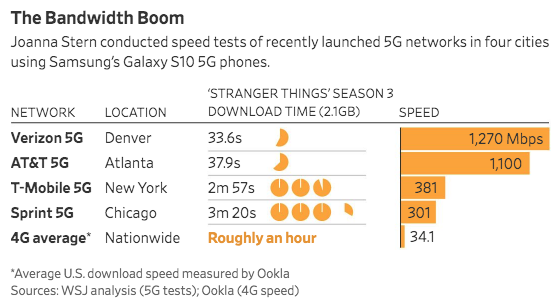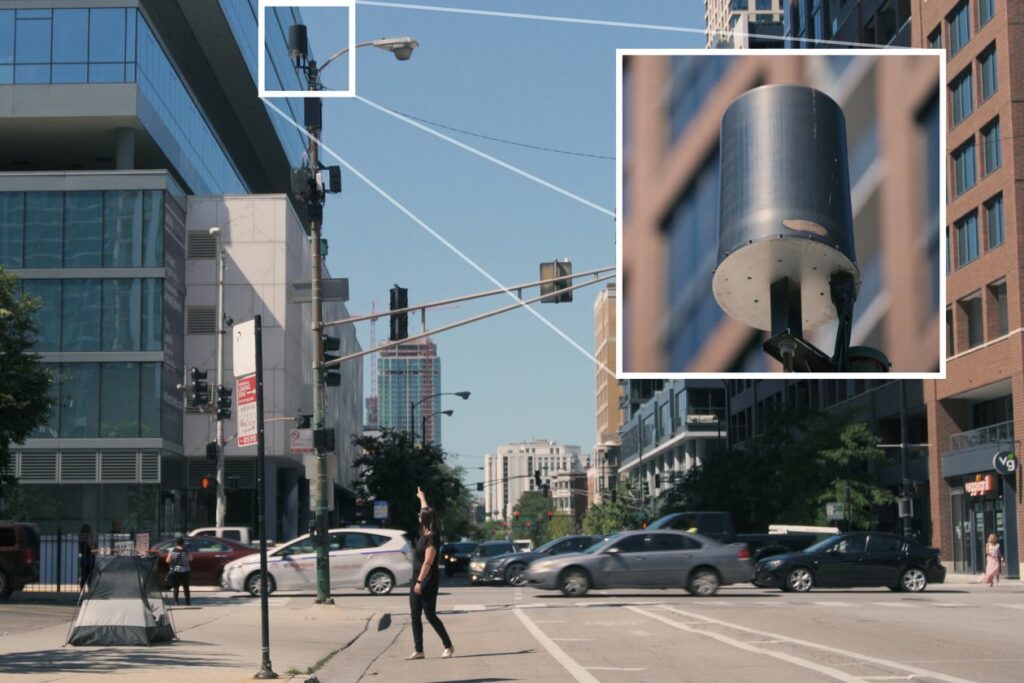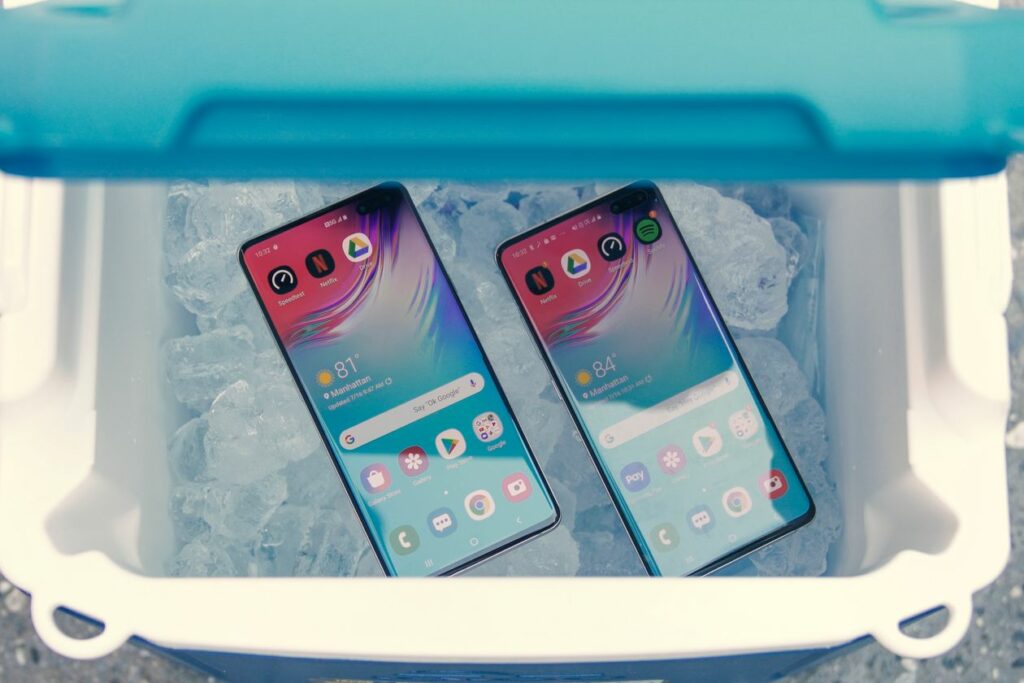We Tested 5G Across America. It’s Crazy Fast—and a Hot Mess
In tests, the 5G often switched off due to summer heat, leaving our columnist to cool the devices with ice packs or air conditioners

5G Testing Results: Pack Your Tent and Cooler
All of the major U.S. carriers—Verizon, AT&T, T-Mobile and Sprint—are launching 5G across the U.S. WSJ’s Joanna Stern embarked on a summer testing tour only to learn that 5G is blazing fast…if you’re outside, near a cell tower, with some way to keep the phone cool.
One of the biggest findings of my multi-city 5G review tour: The Samsung Galaxy S10 5G isn’t reliable in the summer—unless, well, you summer in Iceland.
When I ran tests, the phone’s 5G often switched off due to overheating, leaving me with a 4G connection. Cellular carriers demo-ing or testing the phone have taken to cooling the devices with ice packs and air conditioners.
The phone does this when the temperature reaches a certain threshold to minimize energy use and optimize battery, a Samsung spokeswoman said. “As 5G technology and the ecosystem evolve, it’s only going to get better,” she added.
The fifth generation of cellular networking, 5G is designed to replace 4G (aka LTE) and pave the way for innovation ranging from augmented reality to self-driving cars. Name any tech buzzword: It’ll probably benefit from 5G’s faster speeds and reduced lag.

A Verizon 5G test in Denver, conducted using Ookla’s Speedtest app, hits 1,500 megabits per second. PHOTO: JOANNA STERN/THE WALL STREET JOURNAL
Leading U.S. carriers are already taking the first steps, launching 5G here and there around the U.S. In just the past few weeks, Sprint launched in Chicago, AT&T T -0.91% in Las Vegas, T-Mobile in New York City and Verizon in Denver and Providence, R.I. By the end of the year, there should be 5G in around 30 U.S. cities.
Eager to test out a technology that’s been more hyped than flavored sparkling water, I embarked on a 5G expedition from Denver to Atlanta to Chicago to Manhattan’s Lower East Side. I mostly used the new, $1,300 Samsung Galaxy S10 5G, one of the first 5G phones and the only one available across all the carriers. I also tested the LG V50 ThinQ 5G on Sprint’s network; Verizon has a version but I didn’t test it.
After nearly 120 tests, more than 12 city miles walked and a couple of big blisters, I can report that 5G is fasten-your-seat-belt fast…when you can find it. And you’re standing outdoors. And the temperature is just right.
As my findings show, 5G is absolutely not ready for you. But like any brand new network technology, it provides a glimpse of the future.
Finding 1: Soooo fast.
“Holy spit!” I said the first time I saw a speed test hit 1,800 megabits per second on Verizon’s network in downtown Denver. (OK, I didn’t actually say “spit.”)
That’s 52 times the average 4G network download speed in the U.S., according to internet speed-test company Ookla. It’s 18 times the speed of my home network.
Don’t speak megabits? I downloaded the whole new season of “Stranger Things” from Netflix —2.1 gigabytes of video—in 34 seconds. The same averaged more than an hour on my 4G connections. And I downloaded a huge, 10GB file full of video and images from Google Drive in 2.5 minutes.
I saw similar “gigabit” speeds from AT&T in Atlanta. I never hit the 1,000-Mbps mark in my tests with T-Mobile and Sprint, though their speeds were still about eight-to-10 times as fast as 4G. My 5G testing sherpa and cellular-networking guru, Sascha Segan of PCMag, has tested these networks in more locations and has also seen these differences between carriers.
Right now, using 5G is like being on a highway with no one else around. Once more people jump on, speeds will likely decrease. But no matter which carrier you’re on, only downloads benefit from 5G. For now, if you want to upload a file or video, you’ll get 4G speeds.
A Verizon millimeter-wave node on top of a street lamp in downtown Chicago. PHOTO:ROBERT ALCARAZ/THE WALL STREET JOURNAL
Finding 2: Got a 5G signal? Don’t move.
With the exception of Sprint, these speeds can be found only in small pockets around town. (More on Sprint below.) In fact, I had to ask carriers for landmarks and street corners to find the coverage.
Right now, Verizon, T-Mobile and AT&T are deploying a high-frequency flavor of 5G called “millimeter wave.” It’s super-duper fast but can’t travel long distances.
In Denver, Verizon has erected 20-foot green poles on street corners to broadcast the signal; in Chicago, it has affixed nodes to street lamps. In Atlanta, I saw nodes AT&T had placed on top of buildings or on existing cell towers; in each of those locations, walking a few hundred feet up or around the block could cause the 5G indicator on my phone to drop to 4G.
Three Roads to 5G
As U.S. carriers roll out the latest generation of cellular networking, the speed and range you’ll get depends in part on your location—and the frequency of the signal.
Low-band
Mid-band
High-band
Higher millimeter-wave frequencies provide the fastest speeds—if you’re near an antenna. Also, signals can’t always penetrate walls.
Verizon, AT&T and T-Mobile offer high-band service in select cities. Sprint hasn’t announced plans.
This works well across long distances and will cover rural areas. Speeds will be greater than 4G but slower than other 5G signals.
AT&T and T-Mobile plan to launch low-band 5G in six to nine months. Verizon and Sprint haven’t announced plans.
Carriers are hunting for more of these bands, which offer greater speeds while covering relatively large distances.
Sprint operates 5G in this band. Other carriers haven’t announced plans.
Source: the companies
Finding 3: Got a 5G signal? Don’t go inside.
Right next to that tower in Denver where I notched those crazy speeds is a small bakery with delicious bread. When I stepped inside, the 5G signal vanished. That’s the other thing about millimeter waves: Most can’t penetrate walls or other hard obstacles.
The carriers plan to use this technology to blanket large outdoor and even indoor spaces. AT&T, for instance, is targeting shopping malls, stadiums and convention centers. Unlike its competitors, AT&T is also restricting the network to business customers looking to develop products for the faster network. (These are the only people who should be buying 5G devices right now anyway.)
Finding 4: AT&T’s 5GE isn’t 5G.
Speaking of AT&T: If you think your current AT&T iPhone or Android phone is a 5G phone because “5GE” sometimes appears in the corner next to your network strength icon, it isn’t. It’s just good 4G, rebranded “5G Evolution” by AT&T’s marketing department.
No matter what carrier you are on, you’ll need a new phone for real 5G. And it’ll likely be a while before Apple launches one.
Finding 5: Ice packs not included.
In Atlanta, where it was 90 degrees the day I visited, I could run only one or two 5G download tests before the phone would overheat and switch to 4G. When that happened, I’d head back to the car and hold the phone to the air vent. In Chicago, another day in the 90s, I had to wait until the sun went down to finish my Netflix download tests. In New York on an 83-degree day, I went with the ice-cooler trick: A minute or two in the cooler, and 5G switches back on.
All it takes is two-to-three minutes in a cooler for an overheated Samsung Galaxy S10 5G phone to reconnect to the 5G network. PHOTO: ROBERT ALCARAZ/THE WALL STREET JOURNAL
At times when the 5G would stop working, my infrared thermometer showed the back surface of the phone was over 100 degrees.
“With 5G, data is transmitted at higher quantities and speeds, which causes the processor to consume more energy,” the Samsung spokeswoman said.
It isn’t atypical for a phone’s processors or modems to reduce functionality when they are heavily taxed or overheated. I put the phone through some intensive tests—although nothing I couldn’t imagine any power user doing. I was surprised, though, when in my tests even a simple download on a normal summer day could overheat the phone and sever the 5G connection.
Finding 6: Sprint finally has an edge.
Millimeter-wave issues like overheating and limited range weren’t problems with another flavor of 5G called “mid-band.”
WHERE ART THOU, 5G?
The latest tally of U.S. cities with 5G networks.
AT&T: Atlanta; Austin, Texas; Charlotte, N.C.; Dallas; Houston; Indianapolis; Jacksonville, Fla.; Las Vegas; Los Angeles; Louisville, Ky.; Nashville, Tenn.; New Orleans; Oklahoma City; Orlando, Fla.; Raleigh, N.C.; San Antonio; San Diego; San Francisco; San Jose, Calif.; Waco, Texas
SPRINT: Atlanta; Chicago; Dallas-Fort Worth; Houston; Kansas City, Mo.
T-MOBILE: Atlanta; Cleveland; Dallas; Las Vegas; Los Angeles; New York
VERIZON: Chicago; Denver; Minneapolis-St. Paul; Providence, R.I.
Currently deployed by Sprint in Chicago, Dallas and other cities, mid-band networks have slower speeds but coverage areas that span much wider distances. I tested Sprint versions of the LG and Samsung phones in various areas of Chicago. Both indicated 5G service the whole time and I notched speeds between 100 to 300 Mbps, including inside my hotel lobby and waiting in line at CVS. Not exactly blistering, but it puts 4G to shame.
“Low-band,” another flavor of 5G that will roll out soon, will also offer slower speeds, cover larger areas and penetrate walls. T-Mobile and AT&T plan to launch in the next six to nine months; Verizon hasn’t announced its plan.
That Galaxy S10 5G phone I’ve been using? It won’t work on those networks. Another reason to hold off.
Finding 7: 5G doesn’t do much right now.
When the stars aligned and things worked, the only real benefit I found was speedily downloading TV shows before a flight. Emailing, web browsing, Instagramming, streaming video—none of that felt any different.
SHARE YOUR THOUGHTS
How long do you plan to wait to buy into 5G? What 5G features are meaningful to you? Join the conversation below.
For now, you can’t use the phone as a hot spot for your laptop or other devices. In Chicago and Atlanta, I used an HTC 5G Hub to connect my laptop to Sprint and got double my home Wi-Fi speeds. This gave me a glimpse of the future: one wireless plan to cover home and mobile needs.
What I’m still excited to see are the real promises of 5G, from AR goggles with a zero-lag visual guide to my surroundings (“Up on your right is the best hot-dog stand in the area”) to fleets of cars that all talk to each other in real-time (“Don’t crash into the nice tech columnist currently crossing 47th Street”).
Those of us who remember the early days of 3G and 4G recall the rocky start. With 5G, the process is even longer and more confusing. “The race to 5G is a race America must win,” President Trump has said. From my weeks on the road, it feels like 5G is still in the locker room. Hopefully there’s air conditioning.
___
https://www.wsj.com/articles/all-the-reasons-not-to-buy-a-5g-phone-right-now-11563467389



